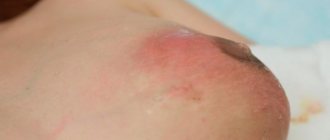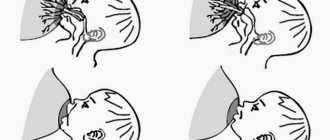WHO recommends weaning a child at the age of 2 years, but 47% of mothers stop breastfeeding (BF) earlier[1]. In half of the cases, the cause is not related to the natural cessation of lactation. More often, the mother is stimulated by the need to go to work or the desire to return to her normal life (for example, remove dietary restrictions or take diet pills).
Weaning is a stressful situation for a child. Before this event, it is important to take into account risk factors, eliminate complications and make the process soft and painless for the baby and mother.
What is not a reason for excommunication?
Every fourth mother gives an argument in favor of giving up breastfeeding: “I feel like it’s time.” But, despite the close connection with the baby, you only need to take into account scientific concepts and medical evidence.
You should not make a decision to wean if the child refuses milk. This is often associated with physiological fluctuations in the child’s body, for example, a decrease in hemoglobin, disturbances in the gastrointestinal tract. It is breast milk that will become the primary medicine in these cases, and weaning will cause complications.
Eating complementary foods and the ability to eat from a plate is not a reason to stop breastfeeding. The composition of milk is not comparable in nutritional value to artificial mixtures and cereals. Properties last up to 2-3 years. Therefore, WHO recommends continuing natural nutrition until the baby is weaned from breastfeeding [2].
Unjustified reasons for weaning
- Lack of appetite in the child.
- Frequent waking up at night.
- Mom goes to work.
- The need to send the baby to a kindergarten or nursery (up to one and a half years).
Sometimes a mother thinks about stopping natural feeding because of the desire to get enough sleep. However, the opinion that a bottle-fed baby will wake up less often is incorrect. The child will continue to require reassurance, mother’s warmth, and rocking, since the cause of anxiety lies in the peculiarities of the infant’s sleep cycle.
A baby older than one year reacts more calmly to the lack of mother's milk, since his digestive system is already adjusted to the new regime. But even a working mother will help her baby adapt better if she continues breastfeeding in the evening and at night. Milk will support the baby’s immunity, and contact during evening feedings will soothe the child who misses his mother. During business trips, it is recommended to express milk rather than suppress lactation.
The need to attend kindergarten for a child under one and a half years old often serves as a reason for weaning from natural feeding. But even in this situation, stopping breastfeeding is unjustified.
After a year, the baby needs to learn to fall asleep without his mother; the skill will stabilize after 2-3 weeks. Dense feeding remains in the morning and before bedtime. Breastfeeding will help the child adapt to kindergarten in a stressful situation.
Mom should think carefully about the need to stop breastfeeding. After all, 3 breastfeedings (700-750 ml) cover ½ of the baby’s daily need for energy and protein, 50% for vitamin A, and 100% for ascorbic acid and tocopherol. Breastfeeding in combination with complementary foods is the key to the full development and health of the child.
How to tune in to the process
First of all, prepare yourself psychologically. Whatever your reasons for giving up breastfeeding, accept the need for it as a fact. There is no need to feel sorry for the “poor baby” who is forcibly “deprived of her mother.” You shouldn’t imagine yourself in the role of a “mother-echidna.” Any hesitation on your part will be sensitively picked up by the baby and will not only complicate and slow down the weaning process, but will also generally cast doubt on its feasibility. Psychologists and teachers know from experience that any significant changes in life (weaning, starting to attend kindergarten, etc.) are much easier for children whose parents are confident in the necessity of this step. So, if you yourself are not yet sure whether to stop breastfeeding, it is better not to try. You will only unnecessarily upset your soul and upset the little one.
So first, be determined. Try to treat a child who is facing a difficult moment not with pity, but with understanding and respect. Yes, the “transition period” may promise tears and whims, but do not treat them tragically. They always accompany important changes in a child’s life, and are not an indicator only of the baby’s suffering. Show with all your appearance that you understand the feelings of the baby and share them, but do not follow their lead. Kids are known to be terrible tricksters. You just have to give in once and the child will instantly take advantage of the “gap.” So take heart - and don’t change horses midstream.
Bad time to wean: pediatrician's opinion
If the question arises about stopping breastfeeding, it is necessary to determine periods when this should not be done. When weaning, the child is already experiencing stress, so it is necessary, if possible, to exclude additional disturbing factors.
Risk situations: summer, stress and illness
- Stress: moving, mom going to work, hiring a nanny, going to nursery.
- Illness and recovery period.
- Days before and after vaccinations.
- Summer months.
Pediatrician E. O. Komarovsky claims that weaning during stressful periods will worsen the child’s nervousness and fear. The baby develops a feeling of uselessness, which provokes moodiness and anxious sleep. The age of risk is considered to be 1 and 3 years, as well as the period of illness. It is recommended to start weaning a child from breastfeeding 2-3 months after a stressful situation.
Vaccination is also considered a stressful moment for the baby’s psyche and physiology. After vaccination, immunity is reduced, leaving a feeling of resentment and fear. Only breast milk can replenish protective resources; stress “releases” after sucking the breast and hugging the mother.
Why can’t we wean off breastfeeding in the summer?
Pediatricians say that summer is a bad time to wean your baby from breastfeeding, as the risk of contracting intestinal infections increases by 40% in the warm months. After breastfeeding stops, the tension of the immune system decreases, and the child’s body becomes vulnerable to the action of pathogens. Mother's milk acts as a protective barrier against infection.
The second factor against weaning off breastfeeding in the summer is the risk of dehydration. In the heat, fluid loss is replenished only by drinking. But the baby does not immediately learn to drink the daily amount of water, because he previously received some of it with milk. It takes time to develop a skill, but if the air temperature goes through the roof, it is unacceptable to hesitate.
The best period to stop breastfeeding is autumn and winter, but age plays a major role. If the baby is less than a year old, then stress for him and for the mother is an integral part of the weaning period.
How to stop quickly
Sometimes circumstances arise that require abrupt breastfeeding.
To do this, you should adhere to the following rules:
- Before deciding to wean, you need to study the literature on this topic. Read forums, find out the experiences of other mothers via the Internet - an abundance of information will help you understand how to abruptly wean from the breast with minimal consequences.
- Naturally, you need to seek recommendations from a gynecologist, therapist or lactation consultant.
- A mother should not reproach herself for wanting to deprive her child of communication with herself through feeding. With sudden weaning, it sometimes happens that there is no time (virtually) for emotional preparation. It is important to understand that there are other ways to maintain connection and trust with your baby.
- Formulate the reason for weaning and always remember it. This could be a nursing illness, the need to undergo surgery, taking medications that are contraindicated for use during lactation, and many others. You need to be strong and confident that weaning off feeding is really necessary.
- Milk may disappear immediately (if you use hormonal drugs) or gradually. It is much more difficult for the baby to get used to the fact that he will no longer eat such delicious milk and will not touch his mother’s breasts, but after a while he will forget about this.
- During abrupt weaning, the breasts continue to swell, which causes discomfort. It is forbidden to bandage the mammary glands - this will lead to lactostasis, mastitis and other diseases of the mammary glands. It is also better not to express milk, as it will begin to be produced again. You can express the milk quite a bit until relief occurs, apply cold compresses or cabbage leaves scratched with a fork (change often) to reduce discomfort.
- Constantly touch your breasts. If you feel “beans”, you need to apply a warm cloth to your chest and massage these places a little. When such manipulations do not bring improvement, you should immediately see a gynecologist or mammologist. You can take Ibuprofen to relieve pain.
- If the mother’s health has sharply deteriorated, the breasts have redness, swollen places, there is a fever or chills, then you need to consult a doctor for help.
- It is recommended to use special pads that are placed in the bra, since milk continues to be released from the breast for some time.
- Mom needs to be prepared for the fact that the mammary glands can change their size. After a few menstruation, she will return to her previous shape (which was before childbirth and feeding).
- There is also a chance of gaining weight after weaning from breastfeeding.
- Depression may occur due to hormonal changes. The nursing body experiences enormous stress during the process of weaning from feeding. Mom needs to be patient so that the body recovers and the hormones return to normal. It is recommended to take up some kind of sport or hobby so that low moods no longer bother you. Physical exercise not only improves your appearance, but also has a positive effect on your emotional background.
- When taking a shower, turn on warm water and direct the stream of water as little as possible onto the mammary glands. While a woman is taking a shower, she can lightly massage her breasts to get rid of lumps.
- When the baby is in your arms, you cannot hold him in the position in which he was fed. The baby will demand to eat, and the mother’s refusal to satisfy his desire leads to crying and hysterics.
It's time to wean your baby off breastfeeding: the best time
The main factor indicating a woman’s readiness to stop breastfeeding is the absence of breast milk or a critical minimum of glandular filling. The observed time period is 12 hours. To check your milk supply, you need to stop feeding and express the milk. For mothers whose children attend nurseries, there will be no problems. It is easy to determine a decrease in lactation by the volume of expressed fluid or by the feeling of breast fullness.
A characteristic sign of a decrease in breast milk: in the absence of night feedings, there is no milk in the morning. It is important not to confuse this phenomenon with blocked ducts. A symptom of lactostasis is soreness, compaction in the glands.
If milk decreases with the same diet and regimen, it’s time to stop lactation.
Determining whether the baby is ready is more difficult. It is recommended to continue feeding until prolactin is produced. Normally, this period lasts 1.5-2 years without failures.
A few words about mom
When you wean your baby, it also takes time for your own body to adjust and stop producing milk. It is almost impossible to predict how this period will unfold for you. There is some dependence: the fewer problems the mother had when she started breastfeeding, that is, the better her individual physiological mechanisms are “debugged,” the easier it is to reverse this process.
If you opt for gradual weaning, your mammary glands will also gradually get used to the reduced “load” and will begin to slow down the process of milk production. The chest will be tense at first. Try to find a middle ground: on the one hand, increasing pressure in the end sections of the glands most effectively inhibits further milk production, on the other hand, it is also not worth bringing the matter to serious engorgement. Express a little at a time to relieve yourself of severe discomfort, but not completely. If milk is completely removed, the body will perceive this as a signal to continue producing it. Some mothers, when their breasts are tense and painful, prefer to give it to their baby. This certainly helps, but keep in mind that in this case you are voluntarily choosing to “roll back” and the process will have to start again.
You can start taking diuretics. It is better if they are “mild”: kidney tea or weight loss tea. Some, especially zealous women, even start drinking laxatives. It is difficult to say how effective they are in this case, but if you have a lot of milk, in principle you can try. Let them also be “mild”: for example, the same tea for weight loss or all kinds of herbal remedies.
If you wean your baby “at once,” your body will be put in more severe conditions. In this case, you may encounter some problems (this does not mean that they are complex and insoluble), but the entire process of extinction of lactation will take much less time.
Ways to wean a child from breast milk at 1 and 2 years of age
There are 3 ways to stop breastfeeding - soft, emergency, medicinal. And, if the mother is unequivocal, WHO recommends strictly following the instructions for proper (gentle) weaning from breastfeeding.
The gentle method in 5 steps
- Eliminate intermediate feedings - to calm the baby when the mother thinks he is hungry (the situation is typical for feeding on demand). It is better to try to calm the child down with hugs, rocking, or singing a song. If you are sure that anxiety is due to hunger, introduce complementary foods.
- Stop feeding after a nap - immediately distract the child with a favorite toy or a new game. It is recommended to remove 1 feeding per week. If the baby has a hard time refusing, the second feeding is excluded after 2 weeks. For 3 weeks, a morning-evening regime is established.
- Eliminate daytime feeding - after breakfast, replace sleep with a walk (2-3 hours). After returning, feed the baby soup, give tea and cookies and put him to bed with a fairy tale. Afternoon snack without feeding (see point 2).
- Stop breastfeeding in the morning - after a week, one breakfast every 7 days is replaced with complementary foods, eliminate 1 feeding per week. The actions are similar to step 2.
- Eliminate feeding before bedtime - 2 weeks before the complete cessation of breastfeeding, add a new bedtime ritual. For example: a bath with chamomile - a glass of milk - a fairy tale. At first, breastfeeding is allowed at night (along with the ritual); after 5-7 days, sucking is canceled. In the first 4-6 weeks, it is better for the father to put the baby to bed.
It is important to replenish the water deficit that occurs with the cancellation of each feeding. A baby needs 50 ml/kg body weight per day. The norm is calculated taking into account that milk satisfies 90% of the daily fluid requirement.
For example, a 1-year-old child weighing 10 kg requires 500 ml of water - this is 3 full feedings. When there is a shortage of normal nutrition with natural nutrition (for example, there are 2 feedings left per day), the baby is supplemented with water from a spoon or bottle.
Rapid weaning methods
Methods when you need to quickly wean a child from the breast are used only in extreme cases. Including severe illnesses of the mother: HIV infection, tumor, open form of tuberculosis, purulent mastitis; when using chemotherapy to treat a woman. The methods are traumatic for mother and child.
- Mom's departure - 3-5 days, transition to formula. A double stressful situation for the baby: interruption of tactile communication and unsatisfied sucking reflex.
- Breast constriction – risk of mastitis 44%. Psychologically difficult for the child, dangerous for the mother.
- The use of hormonal drugs is a modern way to suppress the production of prolactin. Valid for 12 hours. Severe adverse reactions are observed due to sudden changes in hormonal levels.
When using medications that are incompatible with feeding, breastfeeding is recommended to be suspended, but not stopped. At this time, the milk is expressed. After completing the course of treatment, it is better to continue natural feeding, especially if the child is less than one and a half years old.
The best way to abruptly wean a baby with minimal risks is to take hormonal medications. The effect comes from one tablet. It has an irreversible effect if the production of prolactin is not provoked by putting the baby to the breast.
Prolactin inhibitor tablets
- Dostinex;
- Cabergoline;
- Bergolak;
- Agalates;
- Bromocriptine.
The drugs have side effects in 65-70% of cases taken. Manifestations: nausea, vomiting, dizziness, tachycardia, decreased blood pressure. Symptoms are observed for 2-5 days, then disappear.
Expert opinion
Sokolova L. S.
Pediatrician of the highest category
To wean your baby from breastfeeding without harm to his health, you need to follow the instructions of the gentle method step by step. The main advantage: the child’s immunity, nervous and hormonal systems painlessly adapt to a new diet. The mother is calm, the child is happy.
Weaning a baby up to one year
The World Health Organization states that breast milk is the only way to increase a baby’s body’s resistance to various infections. That is why weaning children under one year old is allowed in extreme cases. The stress that the baby will experience is tantamount to parting with his mother.
If the situation requires weaning your child off breastfeeding early, it is recommended to do this before 10 months or 8-12 weeks after the first birthday. Pediatricians consider the age of one to be a critical moment in a child’s mental and physical maturity. Weaning at 11-13 months threatens the baby with allergies, gastrointestinal disorders, and decreased immunity. The result is frequent colds and infections.
Immediately or gradually?
Someone may decide to stop breastfeeding at once, immediately offering the baby milk substitutes. To be fair, it must be said that many children tolerate such a transition very calmly and do not express any dissatisfaction. Others will prefer to gradually reduce the number of feedings. On the one hand, this option will enable the child to rebuild in stages, but on the other hand, it may turn out to be more difficult for the baby. No matter how much you would like to, it is difficult to give definite advice here. Perhaps we can recommend trying: if the baby responds favorably to replacing one feeding first, and then another in a day or two, then we can say that the gradual option is right for you. This way you will reduce the number of feedings to zero or bring them to an acceptable amount. If the child finds it painful to replace the breast with a bottle or sippy cup, you will have to resort to a more drastic option. It may cause violent protests, but the adaptation period will end sooner.
Breasts during weaning
If a gentle method is used, milk continues to be produced for 4-8 weeks. With an abrupt cessation of breastfeeding (without pills), congestive glandular diseases are diagnosed in 20% of cases. Lumps form in the breast and an abscess may develop. More often, complications appear on the 3rd day after complete cessation of breastfeeding and are accompanied by severe pain and inflammation. To eliminate these problems, special recommendations have been developed.
Rules for breast care during forced cessation of lactation
- If the weaning was abrupt, it is better to express milk according to the principle of the soft method - gradual curtailing of breastfeeding.
- Carry out the procedure 4-5 times a day until the breasts are soft, reduce the number of pumpings every 5 days.
- When expressing, leave a little milk - this way it will “burn out” faster.
- Wear a bralette made of cotton fabric.
- Drink herbal decoctions and teas - mint, lingonberry, sage, parsley.
- To relieve inflammation, use cool compresses (hot ones are not allowed).
- For pain relief, chilled cabbage leaves (brushed first) are recommended.
- In case of severe pain or a temperature above 38.0°C, you can take paracetamol.
- It is allowed to take sedatives at night (Valocordin, motherwort).
- If inflammation and pain increase, you need to contact a mammologist.
Unpleasant sensations normally go away after 2 weeks. The mild method of weaning is less often accompanied by inflammation of the glands.
Lumpiness in the breast is the first sign of lactostasis. It is necessary to consult a doctor to determine tactics for further cessation of lactation.
Emergency weaning
In this situation, the woman is faced with the question of what to do with the milk, where to put it? We have already written that if you want to continue breastfeeding after your recovery, you can simply express milk. But if you are not going to return to breastfeeding, then lactation (milk secretion) should be suppressed.
Here are some considerations and recommendations in addition to those already listed:
- Try to maintain a drinking regime similar to that in the first days after childbirth, that is, drink no more than 500-700 ml of liquids per day, including first courses and juicy fruits. It may seem difficult, but don’t worry: it was after giving birth that you were terribly thirsty, now everything will be different.
- Attitudes towards breast tightening today are very controversial. Those who use this recommendation are usually satisfied, but experts consider this procedure harmful: sometimes it leads to the development of milk stagnation (lactostasis) and inflammation of the mammary glands (mastitis).
- The doctor may prescribe a drug that suppresses lactation - bromocriptine (also known as Parlodel). It stops the production of the anterior pituitary hormone prolactin (this hormone causes milk production), and the mammary glands thus lose their “guiding thread”.
The same recommendations can be used for “planned” weaning.
Be patient and good luck!
When should you not wean?
You should not wean your baby from the breast during difficult periods for him (illness, the beginning of babysitting, potty training) and for you (going to work, moving, changing family composition). If you can foresee some event that will cause you to stop breastfeeding, it is better to wean your baby in advance.
Acute infections in the mother (ARVI, mild to moderate food poisoning, manifestations of herpes, etc.) are not contraindications for breastfeeding if it is treated only with herbal or external means. When prescribing drugs orally and in severe cases of any acute illness, you should definitely consult with your doctor regarding the safety of continuing feeding.
For airborne infections (ARVI) during breastfeeding, preventive measures should be taken: a four-layer gauze mask.
Magazine “Mom and Baby” No. 9, 2004











